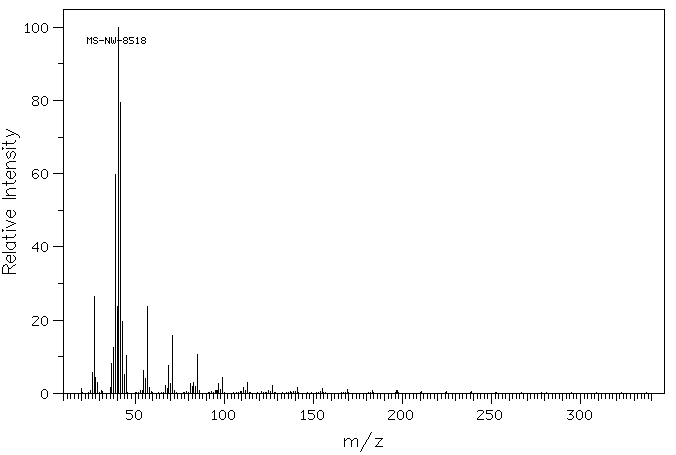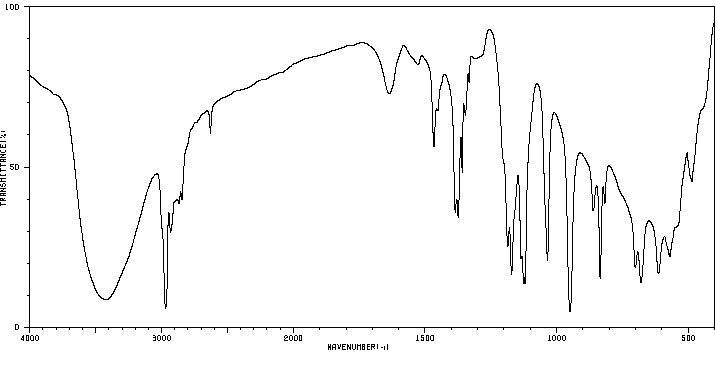aluminum isopropoxide
中文名称
——
中文别名
——
英文名称
aluminum isopropoxide
英文别名
aluminium isopropoxide;Aluminum tri-iso-propoxide;tri(propan-2-yloxy)alumane
CAS
——
化学式
C9H21AlO3
mdl
——
分子量
204.245
InChiKey
SMZOGRDCAXLAAR-UHFFFAOYSA-N
BEILSTEIN
——
EINECS
——
-
物化性质
-
计算性质
-
ADMET
-
安全信息
-
SDS
-
制备方法与用途
-
上下游信息
-
文献信息
-
表征谱图
-
同类化合物
-
相关功能分类
-
相关结构分类
计算性质
-
辛醇/水分配系数(LogP):-1.12
-
重原子数:13
-
可旋转键数:0
-
环数:0.0
-
sp3杂化的碳原子比例:1.0
-
拓扑面积:69.2
-
氢给体数:0
-
氢受体数:3
ADMET
代谢
铝通过口服或吸入暴露的吸收情况很差,基本上不通过皮肤吸收。铝的生物利用度受到铝化合物的影响,以及饮食成分的存在,这些成分可以与铝形成络合物,增强或抑制其吸收。铝在血液中与各种配体结合,并分布到每个器官,其中在骨骼和肺组织中的浓度最高。在生物体中,铝被认为存在四种不同形式:作为自由离子,作为低分子量络合物,作为物理结合的大分子络合物,以及作为共价结合的大分子络合物。吸收的铝主要通过尿液排出,其次是在胆汁中,而未吸收的铝则通过粪便排出。(L739)
Aluminum is poorly absorbed following either oral or inhalation exposure and is essentially not absorbed dermally. The bioavailability of aluminum is strongly influenced by the aluminum compound and the presence of dietary constituents which can complex with aluminum and enhance or inhibit its absorption. Aluminum binds to various ligands in the blood and distributes to every organ, with highest concentrations found in bone and lung tissues. In living organisms, aluminum is believed to exist in four different forms: as free ions, as low-molecular-weight complexes, as physically bound macromolecular complexes, and as covalently bound macromolecular complexes. Absorbed aluminum is excreted principally in the urine and, to a lesser extent, in the bile, while unabsorbed aluminum is excreted in the faeces. (L739)
来源:Toxin and Toxin Target Database (T3DB)
毒理性
铝的主要靶器官是中枢神经系统和骨骼。铝与饮食中的磷结合,并影响胃肠道对磷的吸收。体内磷负荷的降低会导致骨软化(由于骨骼矿化缺陷导致的骨质疏松)和佝偻病。铝的神经毒性被认为涉及多种机制。细胞骨架蛋白功能的改变,如磷酸化、蛋白水解、运输和合成的改变,被认为是其中一个原因。铝可能通过影响血脑屏障的通透性、胆碱能活性、信号转导途径、脂质过氧化以及损害神经元的谷氨酸一氧化氮-环磷酸鸟苷酸途径,以及由于类似的配位化学性质和随后的竞争性相互作用而干扰必需微量元素的代谢,从而诱导神经行为效应。有研究表明,铝与雌激素受体的相互作用增加了雌激素相关基因的表达,从而促进了乳腺癌的进展(A235),但研究尚未能够建立铝与乳腺癌风险增加之间的明确联系(A15468)。某些铝盐通过激活炎症小体来诱导免疫反应。(L739, A235, A236)
The main target organs of aluminum are the central nervous system and bone. Aluminum binds with dietary phosphorus and impairs gastrointestinal absorption of phosphorus. The decreased phosphate body burden results in osteomalacia (softening of the bones due to defective bone mineralization) and rickets. Aluminum's neurotoxicity is believed to involve several mechanisms. Changes in cytoskeletal protein functions as a results of altered phosphorylation, proteolysis, transport, and synthesis are believed to be one cause. Aluminum may induce neurobehavioral effects by affecting permeability of the blood-brain barrier, cholinergic activity, signal transduction pathways, lipid peroxidation, and impair neuronal glutamate nitric oxide-cyclic GMP pathway, as well as interfere with metabolism of essential trace elements because of similar coordination chemistries and consequent competitive interactions. It has been suggested that aluminum's interaction with estrogen receptors increases the expression of estrogen-related genes and thereby contributes to the progression of breast cancer (A235), but studies have not been able to establish a clear link between aluminum and increased risk of breast cancer (A15468). Certain aluminum salts induce immune responses by activating inflammasomes. (L739, A235, A236)
来源:Toxin and Toxin Target Database (T3DB)
毒理性
A4;不可分类为人类致癌物。/铝金属和难溶化合物/
A4; Not classifiable as a human carcinogen. /Aluminum metal and insoluble compounds/
来源:Hazardous Substances Data Bank (HSDB)
毒理性
未列于国际癌症研究机构(IARC)名录。国际癌症研究机构将铝生产归类为对人类致癌(第1组),但并未指认铝本身是人类致癌物。(L135)有人提出铝制止汗剂的使用与乳腺癌风险增加之间存在关联(A235),但研究并未能确立明确的联系(A15468)。
Not listed by IARC. IARC classified aluminum production as carcinogenic to humans (Group 1), but did not implicate aluminum itself as a human carcinogen. (L135) A link between use of aluminum-containing antiperspirants and increased risk of breast cancer has been proposed (A235), but studies have not been able to establish a clear link (A15468).
来源:Toxin and Toxin Target Database (T3DB)
毒理性
铝针对神经系统,导致神经系统性能下降,并与血脑屏障功能改变有关。体内铝的积累可能导致骨骼或脑部疾病。高水平的铝与阿尔茨海默病有关。少数人对铝过敏,在接触或摄入含有铝的产品时,会经历接触性皮炎、消化紊乱、呕吐或其他症状。
Aluminum targets the nervous system and causes decreased nervous system performance and is associated with altered function of the blood-brain barrier. The accumulation of aluminum in the body may cause bone or brain diseases. High levels of aluminum have been linked to Alzheimer's disease. A small percentage of people are allergic to aluminium and experience contact dermatitis, digestive disorders, vomiting or other symptoms upon contact or ingestion of products containing aluminium. (L739, L740)
来源:Toxin and Toxin Target Database (T3DB)
毒理性
口服(L739);吸入(L739)
Oral (L739) ; inhalation (L739)
来源:Toxin and Toxin Target Database (T3DB)
反应信息
-
作为反应物:描述:参考文献:名称:STERZEL, HANS-JOSEF摘要:DOI:
-
作为产物:描述:参考文献:名称:LOS, G. P.;ZINOVEV, O. I.;MARGULIS, M. A., 1990) 12 S., IL., ONIITEHXIM G. CHERKASSY, 619-XP90摘要:DOI:
-
作为试剂:参考文献:名称:Structure–activity relationships of oxysterol-derived pharmacological chaperones for Niemann–Pick type C1 protein摘要:Niemann-Pick disease type C is a fatal neurodegenerative disease, and its major cause is mutations in NPC1 gene. This gene encodes NPC1 protein, a late endosomal polytopic membrane protein required for intracellular cholesterol trafficking. One prevalent mutation (11061T) has been shown to cause a folding defect, which results in failure of endosomal localization of the protein, leading to loss-of-function phenotype. We have previously demonstrated that several oxysterols and their derivatives act as pharmacological chaperones; binding of these compounds to NPC1(11061T) mutant protein corrects the localization/maturation defect of the mutant protein. Here, we disclose detailed structure-activity relationships of oxysterol derivatives as pharmacological chaperones for NPC1(11061T) mutant. (C) 2014 Elsevier Ltd. All rights reserved.DOI:10.1016/j.bmcl.2014.05.064
文献信息
-
Mechanochemical Nonhydrolytic Sol–Gel-Strategy for the Production of Mesoporous Multimetallic Oxides作者:Zihao Zhang、Shize Yang、Xiaobing Hu、Haidi Xu、Honggen Peng、Miaomiao Liu、Bishnu Prasad Thapaliya、Kecheng Jie、Jiahua Zhao、Jixing Liu、Hao Chen、Yan Leng、Xiuyang Lu、Jie Fu、Pengfei Zhang、Sheng DaiDOI:10.1021/acs.chemmater.9b01244日期:2019.8.13fabricate mesoporous metal (Cu, Co, Mn, Fe, Mg, Ni)-aluminum binary oxide by using anhydrous metal chlorides and aluminum isopropoxide interplay. More importantly, four or five metals-aluminum oxide complexes with abundant mesopores and single cubic crystalline phase known as high-entropy ceramics are produced. To the best of our knowledge, mesoporous high-entropy metal oxides have not been prepared具有宽孔尺寸,高表面积和均匀多孔结构的中孔金属氧化物在各种领域中显示出优异的优点。然而,现有技术的合成方法主要是湿化学法,伴随使用过量的溶剂,以及耗时的干燥过程。本文中,我们报告了通过异丙醇铝共聚物组装合成介孔Al 2 O 3(meso-Al 2 O 3)的机械化学固态路线。所得的中观Al 2 O 3表现出创纪录的高表面积(〜644 m 2 g –1)和狭窄的孔径分布(以〜5 nm为中心)。此外,通过使用无水金属氯化物和异丙醇铝的相互作用,引入了机械化学非水解溶胶-凝胶策略来制备介孔金属(铜,钴,锰,铁,镁,镍)-铝二元氧化物。更重要的是,生产了具有丰富的中孔和单一立方晶相的四种或五种金属-氧化铝复合物,称为高熵陶瓷。据我们所知,中孔高熵金属氧化物以前尚未制备,因为高结晶温度会使中孔塌陷。另外,这种高熵性质赋予(CuNiFeCoMg)O x –Al 2 O 3优异的SO 2与单一CuO–Al
-
Synthesis, Crystal Structures, and Thermolysis Studies of Heteronuclear Transition Metal Aluminum Alcoholates作者:Sebastian Küsel、Harald KrautscheidDOI:10.1002/zaac.202000246日期:2020.9.14Zn) are formed by adduct formation of [MAl(OiPr)4}2] (1‐M, M = Fe, Co, Ni, Cu, Zn) with 2,2'‐bipyridine and transesterification reaction with cHexOAc. According to crystal structure analyses, in 2‐M and 3‐M the central transition metal ion M2+ is coordinated by two chelating Al(OR)4– moieties and one bipyridine ligand in an octahedral arrangement. Treating 1‐Cu with 2,2'‐bipyridine leads to a reduction异核醇盐配合物[M Al(O i Pr)4 } 2(bipy)](2‐M,M = Fe,Co,Ni,Cu,Zn)和[M Al(O c Hex)4 } 2( bipy)](3‐M,M = Fe,Co,Ni,Zn)通过[M Al(O i Pr)4 } 2 ](1 ‐ M,M = Fe,Co,Ni, Cu,Zn)与2,2'-联吡啶和c HexOAc进行酯交换反应。根据晶体结构分析,在2M和3M中中心过渡金属离子M 2+由两个八面体排列的螯合Al(OR)4 –部分和一个联吡啶配体协调。用2,2'-联吡啶处理1-Cu会导致还原过程,其中中间体[Cu Al(O i Pr)4 }(bipy)2 ] [Al(O i Pr)4 ](4)可能是结构特征。在1-Cu中异丙醇酸酯配体转化为环己酸酯配体的过程中,Cu 2+还原为Cu +形成[Cu Al(O c Hex)4 }(py)2 ](5)。报告了UV
-
Understanding the Mechanism of Polymerization of ε-Caprolactone Catalyzed by Aluminum Salen Complexes作者:Maria O. Miranda、Yvonne DePorre、Hugo Vazquez-Lima、Michelle A. Johnson、Daniel J. Marell、Christopher J. Cramer、William B. TolmanDOI:10.1021/ic402255m日期:2013.12.2Studies of the kinetics of polymerization of ε-caprolactone (CL) by salen-aluminum catalysts comprising ligands with similar steric profiles but different electron donating characteristics (R = OMe, Br, or NO2) were performed using high initial monomer concentrations (2 M < [CL]0 < 2.6 M) in toluene-d8 at temperatures ranging from 20 to 90 °C. Saturation behavior was observed, enabling determination使用高初始单体浓度(2 M ),通过包含具有相似空间分布但给电子特性不同(R = OMe,Br或NO 2)的配体的萨伦-铝催化剂,对ε-己内酯(CL)的聚合动力学进行了研究。<[CL] 0 <2.6 M)在甲苯中d 8在20至90°C的温度范围内。观察到饱和行为,使得能够确定作为R和温度的函数的单体平衡常数(K eq)和催化速率常数(k 2)。当K eq随R的给电子性质而略有变化时(Hammettρ= +0.16(8)),k 2ρ= +1.4(1)反映出更显着的依赖性。热力学参数Δ ģ °(与相关联的ķ当量)和Δ ģ ⧧(具有相关的ķ 2被测定,使用前者)〜0千卡/摩尔的所有催化剂,后者表现出的趋势R = OME>溴> NO 2。进行密度泛函理论(DFT)计算以在微观细节层次上表征机械通路。最低的能量过渡态结构的特征是亲核体与接近金属离子的内酯羰基的初期键合,但独特的CL加合物在反应路径上
-
Supramolecular Light‐Harvesting Antennas of Metal‐Coordinated Bis(8‐Hydroxyquinoline)‐Substituted Porphyrin Networks作者:Junko Fujimoto、Sari Hayashi、Hideyuki Kainuma、Kazuhiro Manseki、Taro Udagawa、Hidekazu MiyajiDOI:10.1002/asia.201900483日期:2019.8Artificial antenna complexes of metal‐coordinated bis(8‐hydroxyquinoline)‐substituted porphyrin networks that mimic antenna chromophores in plants were organized on titanium dioxide electrodes in photoelectrochemical cells. The generated photocurrents can be optimized according to the two ways of porphyrin self‐assembly due to the “antenna effect”: changing the number of assembled porphyrin monolayers
-
Synthesis and Structure of an Aluminum Bis(3-chloropentanedionate) Isopropoxide: [Al(μ-O<sup>i</sup>Pr)(3-Clacac)<sub>2</sub>]<sub>2</sub>作者:Kiran Gupta、Peter Mayer、Ashutosh PandeyDOI:10.5560/znb.2014-3332日期:2014.7.1
1A [Al(OiPr)3]4 was reacted at ambient temperature with 3-chloropentanedione (3-ClacacH) in 1 : 1 molar ratio in toluene, to obtain the mono-substituted product. However, the bis-substituted dinuclear tetrakis(3-chloropentanedionato)-di-m-isopropoxy-dialuminum(III) [Al(μ-OiPr)(3-Clacac)2]2 () was isolated in 46% yield upon aging of the reaction mixture at −10 °C. The supernatant upon aging yielded a crop of tris-3-chloroacetylacetonate Al(3-Clacac)3·H2O (1) in 13% yield. Complexes
1A (monoclinic, space group P21/c with Z = 2) and 1(cubic, space group P43n with Z = 8) were characterized by elemental analyses, NMR and IR spectroscopy and single-crystal X-ray crystallography.
表征谱图
-
氢谱1HNMR
-
质谱MS
-
碳谱13CNMR
-
红外IR
-
拉曼Raman
-
峰位数据
-
峰位匹配
-
表征信息
同类化合物
鲜草醛
马赛醛
顺式-环丙基-1,2-二甲醛
顺式-1-甲酰基-2-(1-己炔基)环丙烷
顺式-1,3-环己烷二甲醛
镁2-甲基丙酸盐
锶二(2-乙基-1-己醇)
锡烷,二丁基二乙氧基-
铝二异丙氧基单仲丁氧醇金属
铈(4+)四(2-甲基-2-丙醇)
過氧化二乙烷
过氧化[(1-甲基亚乙基)二-4-环己基-1-亚基]四(1,1-二甲乙基)
过氧化,3-溴丙基1,1-二甲基乙基
过氧化,1,1-二甲基乙基1-甲基乙基
表水蓼二醛
螺[4.5]癸烷-10-甲醛
聚(1-癸烯:二氧化硫)
羟基甲基叔-丁基过氧化物
甲醛-14C
甲醛-13C,D2
甲醛-13C
甲醛 [3H]
甲烷水合物
甲基6,7-二氧杂-2,3-二氮杂双环[3.2.2]壬-3,8-二烯-2-羧酸酯
甘油三酸酯过氧化物
环辛烷甲醛
环辛烷-1,4-二甲醛
环戊基甲醛
环戊基叔丁基过氧化物
环戊-3-烯-1-甲醛
环戊-2-烯-1-甲醛
环戊-2,4-二烯-1-甲醛
环戊-1,4-二烯-1-甲醛
环庚烷甲醛
环己甲醛,1,4,4-三甲基-
环己烷基甲醛
环己烷-1,3-二甲醛
环十二烷甲醛
环亚己基二[(1,1-二甲基丙基)]过氧化物
环丙甲醛
环丙-2-烯-1-甲醛
环丁基甲醛
环丁-2-烯-1-甲醛
水蓼二醛
氯代钒酸二乙酯
松油
异绒白乳菇醛
异丙醇镨(III)
异丙醇镧
异丙醇锶








